Human Resources Perspective: Benefits of Ergonomics in the Workplace
VerifiedAdded on 2023/02/01
|7
|1855
|89
Report
AI Summary
This report delves into the human resources benefits of implementing ergonomic principles in the workplace. It begins with an introduction highlighting the importance of ergonomics in creating safer and more comfortable work environments, reducing the risk of musculoskeletal disorders (MSDs), and improving employee productivity and engagement. The report outlines the aims, objectives, and research questions that guide the study, followed by a comprehensive literature review covering topics such as MSDs, ergonomic programs, anthropometry, seating, and ergonomic principles. The methodology section details the use of a survey to gather data from employees, the statistical software used for analysis, and the hypotheses being tested. The report concludes with a summary of the research proposal, emphasizing the potential of ergonomics to enhance productivity, reduce costs, decrease MSDs, and boost employee engagement. The references provide a list of sources cited throughout the report.

Human Resources benefits of Ergonomics in the workplace
Table of Contents
Introduction................................................................................................................................2
Aim, objectives and research questions.....................................................................................2
Literature Review.......................................................................................................................2
Methods......................................................................................................................................5
Conclusions................................................................................................................................5
References..................................................................................................................................6
1
Table of Contents
Introduction................................................................................................................................2
Aim, objectives and research questions.....................................................................................2
Literature Review.......................................................................................................................2
Methods......................................................................................................................................5
Conclusions................................................................................................................................5
References..................................................................................................................................6
1
Paraphrase This Document
Need a fresh take? Get an instant paraphrase of this document with our AI Paraphraser
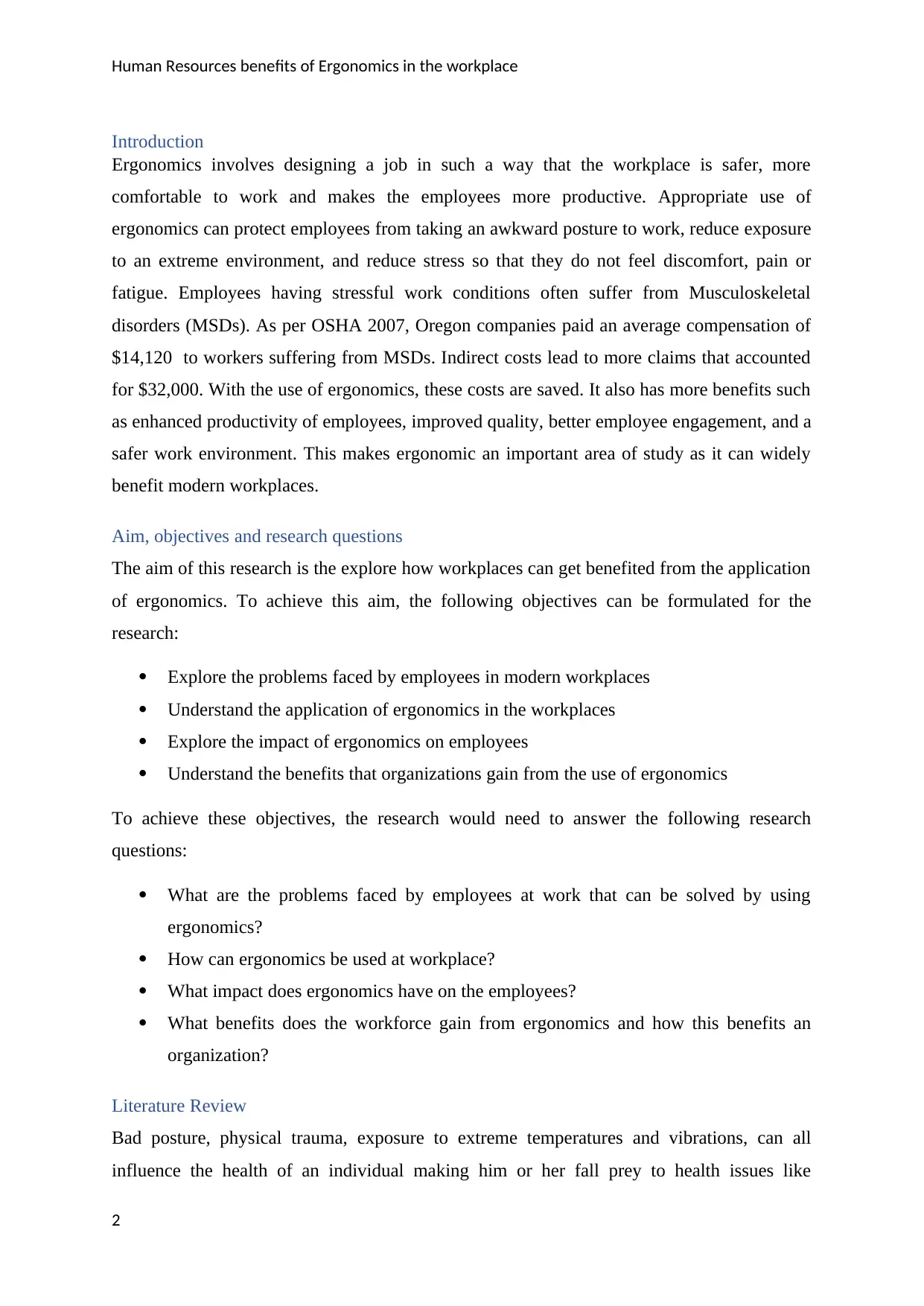
Human Resources benefits of Ergonomics in the workplace
Introduction
Ergonomics involves designing a job in such a way that the workplace is safer, more
comfortable to work and makes the employees more productive. Appropriate use of
ergonomics can protect employees from taking an awkward posture to work, reduce exposure
to an extreme environment, and reduce stress so that they do not feel discomfort, pain or
fatigue. Employees having stressful work conditions often suffer from Musculoskeletal
disorders (MSDs). As per OSHA 2007, Oregon companies paid an average compensation of
$14,120 to workers suffering from MSDs. Indirect costs lead to more claims that accounted
for $32,000. With the use of ergonomics, these costs are saved. It also has more benefits such
as enhanced productivity of employees, improved quality, better employee engagement, and a
safer work environment. This makes ergonomic an important area of study as it can widely
benefit modern workplaces.
Aim, objectives and research questions
The aim of this research is the explore how workplaces can get benefited from the application
of ergonomics. To achieve this aim, the following objectives can be formulated for the
research:
Explore the problems faced by employees in modern workplaces
Understand the application of ergonomics in the workplaces
Explore the impact of ergonomics on employees
Understand the benefits that organizations gain from the use of ergonomics
To achieve these objectives, the research would need to answer the following research
questions:
What are the problems faced by employees at work that can be solved by using
ergonomics?
How can ergonomics be used at workplace?
What impact does ergonomics have on the employees?
What benefits does the workforce gain from ergonomics and how this benefits an
organization?
Literature Review
Bad posture, physical trauma, exposure to extreme temperatures and vibrations, can all
influence the health of an individual making him or her fall prey to health issues like
2
Introduction
Ergonomics involves designing a job in such a way that the workplace is safer, more
comfortable to work and makes the employees more productive. Appropriate use of
ergonomics can protect employees from taking an awkward posture to work, reduce exposure
to an extreme environment, and reduce stress so that they do not feel discomfort, pain or
fatigue. Employees having stressful work conditions often suffer from Musculoskeletal
disorders (MSDs). As per OSHA 2007, Oregon companies paid an average compensation of
$14,120 to workers suffering from MSDs. Indirect costs lead to more claims that accounted
for $32,000. With the use of ergonomics, these costs are saved. It also has more benefits such
as enhanced productivity of employees, improved quality, better employee engagement, and a
safer work environment. This makes ergonomic an important area of study as it can widely
benefit modern workplaces.
Aim, objectives and research questions
The aim of this research is the explore how workplaces can get benefited from the application
of ergonomics. To achieve this aim, the following objectives can be formulated for the
research:
Explore the problems faced by employees in modern workplaces
Understand the application of ergonomics in the workplaces
Explore the impact of ergonomics on employees
Understand the benefits that organizations gain from the use of ergonomics
To achieve these objectives, the research would need to answer the following research
questions:
What are the problems faced by employees at work that can be solved by using
ergonomics?
How can ergonomics be used at workplace?
What impact does ergonomics have on the employees?
What benefits does the workforce gain from ergonomics and how this benefits an
organization?
Literature Review
Bad posture, physical trauma, exposure to extreme temperatures and vibrations, can all
influence the health of an individual making him or her fall prey to health issues like
2
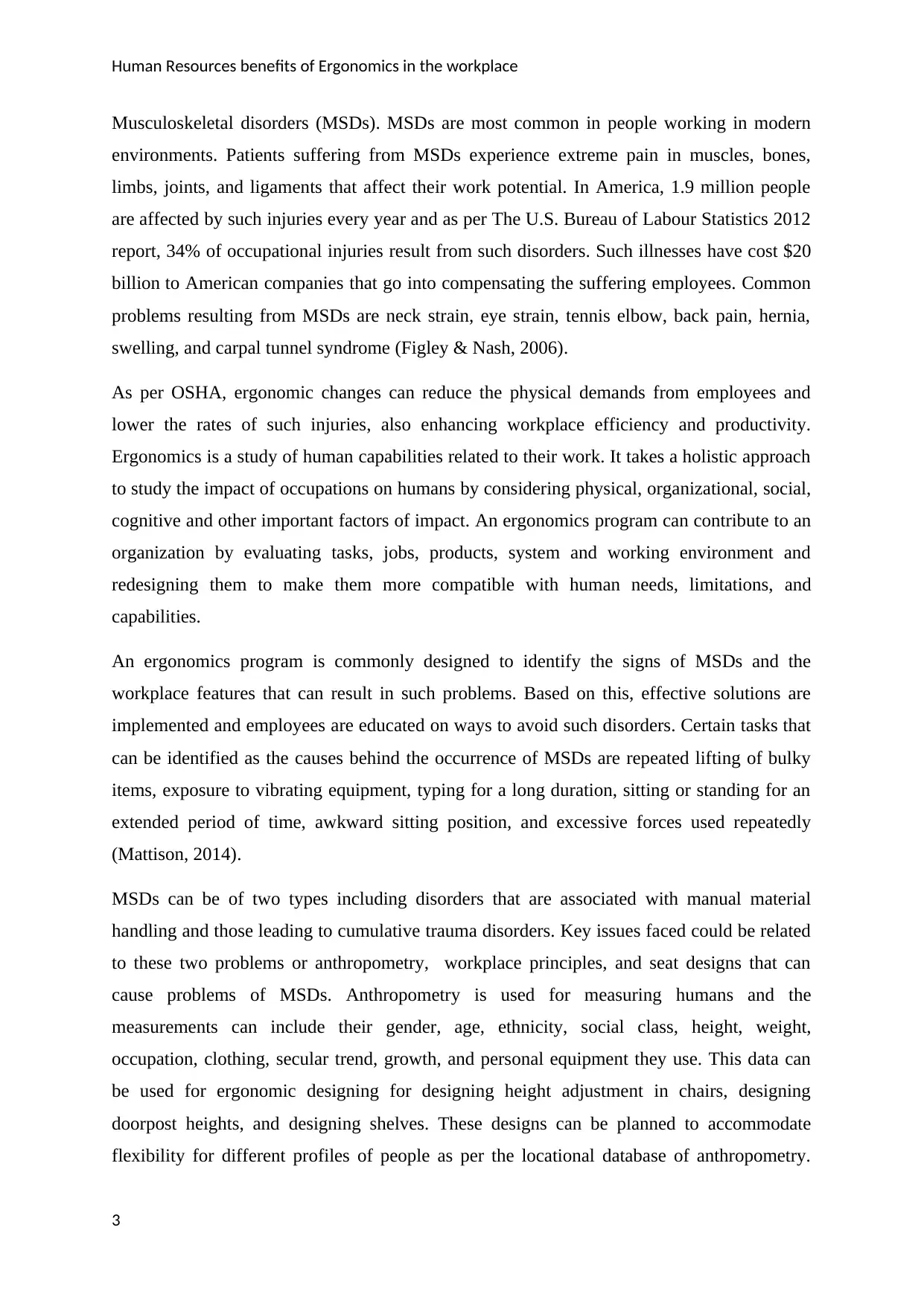
Human Resources benefits of Ergonomics in the workplace
Musculoskeletal disorders (MSDs). MSDs are most common in people working in modern
environments. Patients suffering from MSDs experience extreme pain in muscles, bones,
limbs, joints, and ligaments that affect their work potential. In America, 1.9 million people
are affected by such injuries every year and as per The U.S. Bureau of Labour Statistics 2012
report, 34% of occupational injuries result from such disorders. Such illnesses have cost $20
billion to American companies that go into compensating the suffering employees. Common
problems resulting from MSDs are neck strain, eye strain, tennis elbow, back pain, hernia,
swelling, and carpal tunnel syndrome (Figley & Nash, 2006).
As per OSHA, ergonomic changes can reduce the physical demands from employees and
lower the rates of such injuries, also enhancing workplace efficiency and productivity.
Ergonomics is a study of human capabilities related to their work. It takes a holistic approach
to study the impact of occupations on humans by considering physical, organizational, social,
cognitive and other important factors of impact. An ergonomics program can contribute to an
organization by evaluating tasks, jobs, products, system and working environment and
redesigning them to make them more compatible with human needs, limitations, and
capabilities.
An ergonomics program is commonly designed to identify the signs of MSDs and the
workplace features that can result in such problems. Based on this, effective solutions are
implemented and employees are educated on ways to avoid such disorders. Certain tasks that
can be identified as the causes behind the occurrence of MSDs are repeated lifting of bulky
items, exposure to vibrating equipment, typing for a long duration, sitting or standing for an
extended period of time, awkward sitting position, and excessive forces used repeatedly
(Mattison, 2014).
MSDs can be of two types including disorders that are associated with manual material
handling and those leading to cumulative trauma disorders. Key issues faced could be related
to these two problems or anthropometry, workplace principles, and seat designs that can
cause problems of MSDs. Anthropometry is used for measuring humans and the
measurements can include their gender, age, ethnicity, social class, height, weight,
occupation, clothing, secular trend, growth, and personal equipment they use. This data can
be used for ergonomic designing for designing height adjustment in chairs, designing
doorpost heights, and designing shelves. These designs can be planned to accommodate
flexibility for different profiles of people as per the locational database of anthropometry.
3
Musculoskeletal disorders (MSDs). MSDs are most common in people working in modern
environments. Patients suffering from MSDs experience extreme pain in muscles, bones,
limbs, joints, and ligaments that affect their work potential. In America, 1.9 million people
are affected by such injuries every year and as per The U.S. Bureau of Labour Statistics 2012
report, 34% of occupational injuries result from such disorders. Such illnesses have cost $20
billion to American companies that go into compensating the suffering employees. Common
problems resulting from MSDs are neck strain, eye strain, tennis elbow, back pain, hernia,
swelling, and carpal tunnel syndrome (Figley & Nash, 2006).
As per OSHA, ergonomic changes can reduce the physical demands from employees and
lower the rates of such injuries, also enhancing workplace efficiency and productivity.
Ergonomics is a study of human capabilities related to their work. It takes a holistic approach
to study the impact of occupations on humans by considering physical, organizational, social,
cognitive and other important factors of impact. An ergonomics program can contribute to an
organization by evaluating tasks, jobs, products, system and working environment and
redesigning them to make them more compatible with human needs, limitations, and
capabilities.
An ergonomics program is commonly designed to identify the signs of MSDs and the
workplace features that can result in such problems. Based on this, effective solutions are
implemented and employees are educated on ways to avoid such disorders. Certain tasks that
can be identified as the causes behind the occurrence of MSDs are repeated lifting of bulky
items, exposure to vibrating equipment, typing for a long duration, sitting or standing for an
extended period of time, awkward sitting position, and excessive forces used repeatedly
(Mattison, 2014).
MSDs can be of two types including disorders that are associated with manual material
handling and those leading to cumulative trauma disorders. Key issues faced could be related
to these two problems or anthropometry, workplace principles, and seat designs that can
cause problems of MSDs. Anthropometry is used for measuring humans and the
measurements can include their gender, age, ethnicity, social class, height, weight,
occupation, clothing, secular trend, growth, and personal equipment they use. This data can
be used for ergonomic designing for designing height adjustment in chairs, designing
doorpost heights, and designing shelves. These designs can be planned to accommodate
flexibility for different profiles of people as per the locational database of anthropometry.
3
⊘ This is a preview!⊘
Do you want full access?
Subscribe today to unlock all pages.

Trusted by 1+ million students worldwide
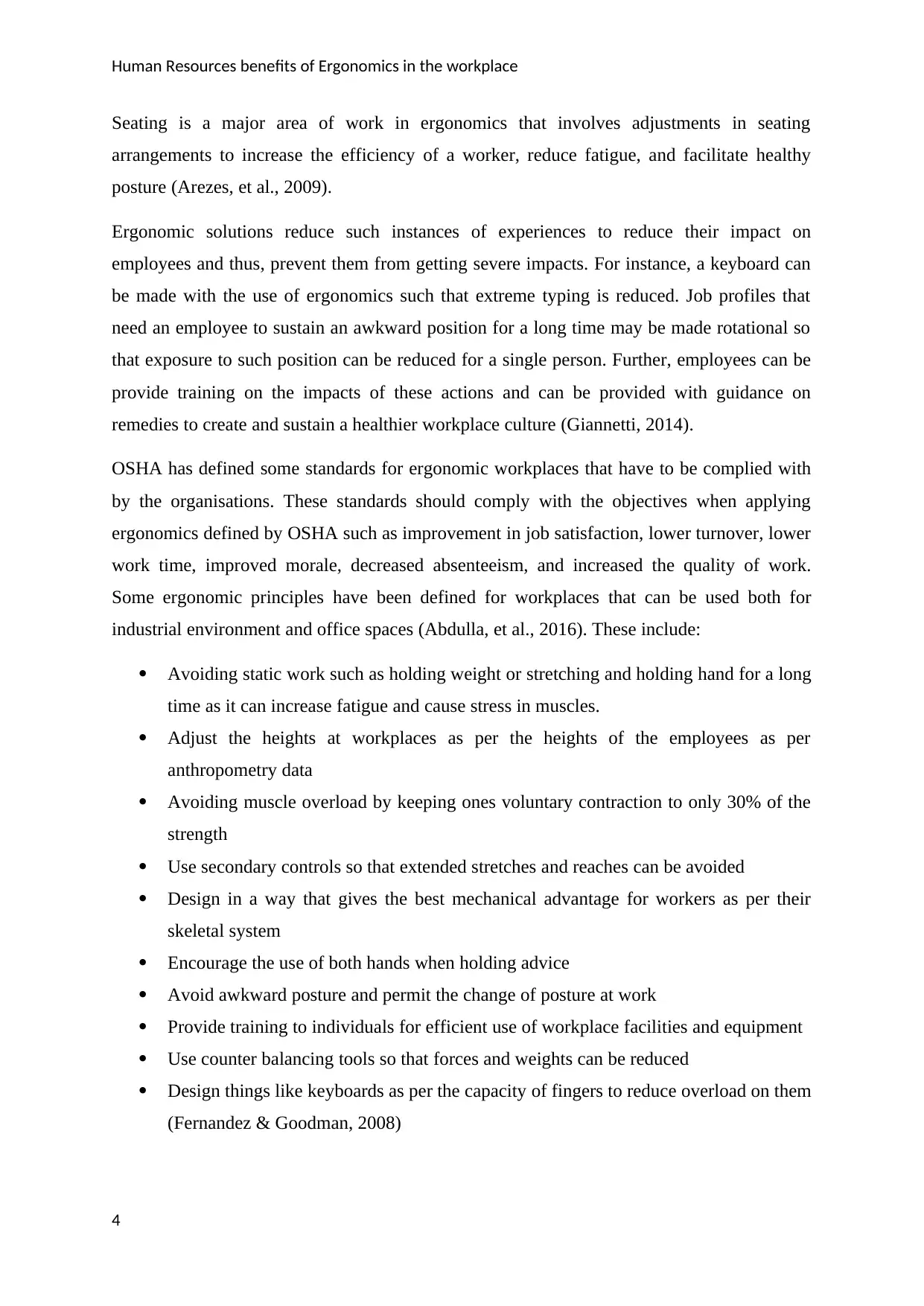
Human Resources benefits of Ergonomics in the workplace
Seating is a major area of work in ergonomics that involves adjustments in seating
arrangements to increase the efficiency of a worker, reduce fatigue, and facilitate healthy
posture (Arezes, et al., 2009).
Ergonomic solutions reduce such instances of experiences to reduce their impact on
employees and thus, prevent them from getting severe impacts. For instance, a keyboard can
be made with the use of ergonomics such that extreme typing is reduced. Job profiles that
need an employee to sustain an awkward position for a long time may be made rotational so
that exposure to such position can be reduced for a single person. Further, employees can be
provide training on the impacts of these actions and can be provided with guidance on
remedies to create and sustain a healthier workplace culture (Giannetti, 2014).
OSHA has defined some standards for ergonomic workplaces that have to be complied with
by the organisations. These standards should comply with the objectives when applying
ergonomics defined by OSHA such as improvement in job satisfaction, lower turnover, lower
work time, improved morale, decreased absenteeism, and increased the quality of work.
Some ergonomic principles have been defined for workplaces that can be used both for
industrial environment and office spaces (Abdulla, et al., 2016). These include:
Avoiding static work such as holding weight or stretching and holding hand for a long
time as it can increase fatigue and cause stress in muscles.
Adjust the heights at workplaces as per the heights of the employees as per
anthropometry data
Avoiding muscle overload by keeping ones voluntary contraction to only 30% of the
strength
Use secondary controls so that extended stretches and reaches can be avoided
Design in a way that gives the best mechanical advantage for workers as per their
skeletal system
Encourage the use of both hands when holding advice
Avoid awkward posture and permit the change of posture at work
Provide training to individuals for efficient use of workplace facilities and equipment
Use counter balancing tools so that forces and weights can be reduced
Design things like keyboards as per the capacity of fingers to reduce overload on them
(Fernandez & Goodman, 2008)
4
Seating is a major area of work in ergonomics that involves adjustments in seating
arrangements to increase the efficiency of a worker, reduce fatigue, and facilitate healthy
posture (Arezes, et al., 2009).
Ergonomic solutions reduce such instances of experiences to reduce their impact on
employees and thus, prevent them from getting severe impacts. For instance, a keyboard can
be made with the use of ergonomics such that extreme typing is reduced. Job profiles that
need an employee to sustain an awkward position for a long time may be made rotational so
that exposure to such position can be reduced for a single person. Further, employees can be
provide training on the impacts of these actions and can be provided with guidance on
remedies to create and sustain a healthier workplace culture (Giannetti, 2014).
OSHA has defined some standards for ergonomic workplaces that have to be complied with
by the organisations. These standards should comply with the objectives when applying
ergonomics defined by OSHA such as improvement in job satisfaction, lower turnover, lower
work time, improved morale, decreased absenteeism, and increased the quality of work.
Some ergonomic principles have been defined for workplaces that can be used both for
industrial environment and office spaces (Abdulla, et al., 2016). These include:
Avoiding static work such as holding weight or stretching and holding hand for a long
time as it can increase fatigue and cause stress in muscles.
Adjust the heights at workplaces as per the heights of the employees as per
anthropometry data
Avoiding muscle overload by keeping ones voluntary contraction to only 30% of the
strength
Use secondary controls so that extended stretches and reaches can be avoided
Design in a way that gives the best mechanical advantage for workers as per their
skeletal system
Encourage the use of both hands when holding advice
Avoid awkward posture and permit the change of posture at work
Provide training to individuals for efficient use of workplace facilities and equipment
Use counter balancing tools so that forces and weights can be reduced
Design things like keyboards as per the capacity of fingers to reduce overload on them
(Fernandez & Goodman, 2008)
4
Paraphrase This Document
Need a fresh take? Get an instant paraphrase of this document with our AI Paraphraser
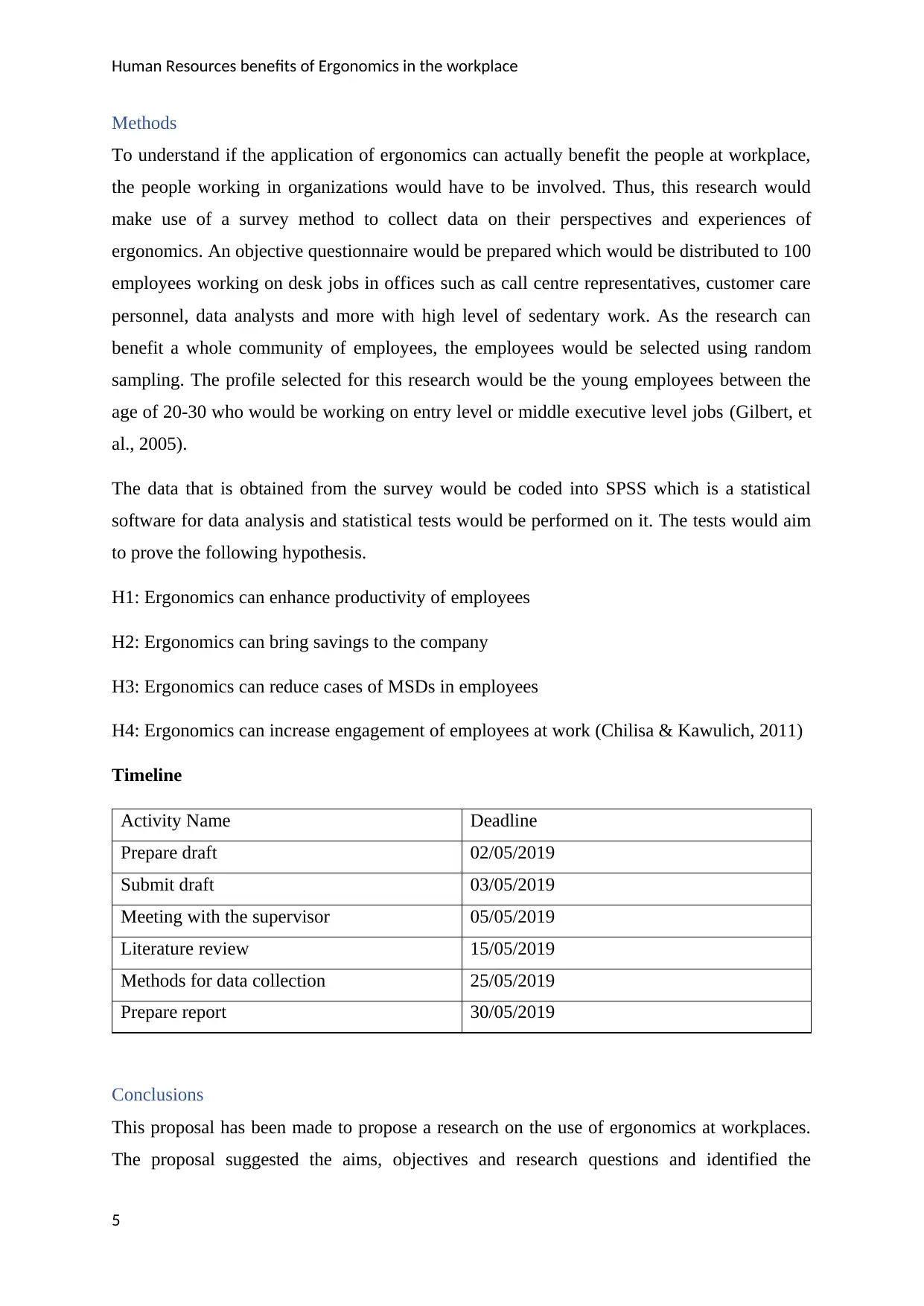
Human Resources benefits of Ergonomics in the workplace
Methods
To understand if the application of ergonomics can actually benefit the people at workplace,
the people working in organizations would have to be involved. Thus, this research would
make use of a survey method to collect data on their perspectives and experiences of
ergonomics. An objective questionnaire would be prepared which would be distributed to 100
employees working on desk jobs in offices such as call centre representatives, customer care
personnel, data analysts and more with high level of sedentary work. As the research can
benefit a whole community of employees, the employees would be selected using random
sampling. The profile selected for this research would be the young employees between the
age of 20-30 who would be working on entry level or middle executive level jobs (Gilbert, et
al., 2005).
The data that is obtained from the survey would be coded into SPSS which is a statistical
software for data analysis and statistical tests would be performed on it. The tests would aim
to prove the following hypothesis.
H1: Ergonomics can enhance productivity of employees
H2: Ergonomics can bring savings to the company
H3: Ergonomics can reduce cases of MSDs in employees
H4: Ergonomics can increase engagement of employees at work (Chilisa & Kawulich, 2011)
Timeline
Activity Name Deadline
Prepare draft 02/05/2019
Submit draft 03/05/2019
Meeting with the supervisor 05/05/2019
Literature review 15/05/2019
Methods for data collection 25/05/2019
Prepare report 30/05/2019
Conclusions
This proposal has been made to propose a research on the use of ergonomics at workplaces.
The proposal suggested the aims, objectives and research questions and identified the
5
Methods
To understand if the application of ergonomics can actually benefit the people at workplace,
the people working in organizations would have to be involved. Thus, this research would
make use of a survey method to collect data on their perspectives and experiences of
ergonomics. An objective questionnaire would be prepared which would be distributed to 100
employees working on desk jobs in offices such as call centre representatives, customer care
personnel, data analysts and more with high level of sedentary work. As the research can
benefit a whole community of employees, the employees would be selected using random
sampling. The profile selected for this research would be the young employees between the
age of 20-30 who would be working on entry level or middle executive level jobs (Gilbert, et
al., 2005).
The data that is obtained from the survey would be coded into SPSS which is a statistical
software for data analysis and statistical tests would be performed on it. The tests would aim
to prove the following hypothesis.
H1: Ergonomics can enhance productivity of employees
H2: Ergonomics can bring savings to the company
H3: Ergonomics can reduce cases of MSDs in employees
H4: Ergonomics can increase engagement of employees at work (Chilisa & Kawulich, 2011)
Timeline
Activity Name Deadline
Prepare draft 02/05/2019
Submit draft 03/05/2019
Meeting with the supervisor 05/05/2019
Literature review 15/05/2019
Methods for data collection 25/05/2019
Prepare report 30/05/2019
Conclusions
This proposal has been made to propose a research on the use of ergonomics at workplaces.
The proposal suggested the aims, objectives and research questions and identified the
5

Human Resources benefits of Ergonomics in the workplace
methods that would be used for data collection and analysis for the current research. It
proposes use of primary research through survey that would be conduced on a sample size of
100 employees working in offices. The collected data would be statistically analysed to
provide the defined hypothesis that are been formulated to achieve the objectives of the
research.
6
methods that would be used for data collection and analysis for the current research. It
proposes use of primary research through survey that would be conduced on a sample size of
100 employees working in offices. The collected data would be statistically analysed to
provide the defined hypothesis that are been formulated to achieve the objectives of the
research.
6
⊘ This is a preview!⊘
Do you want full access?
Subscribe today to unlock all pages.

Trusted by 1+ million students worldwide
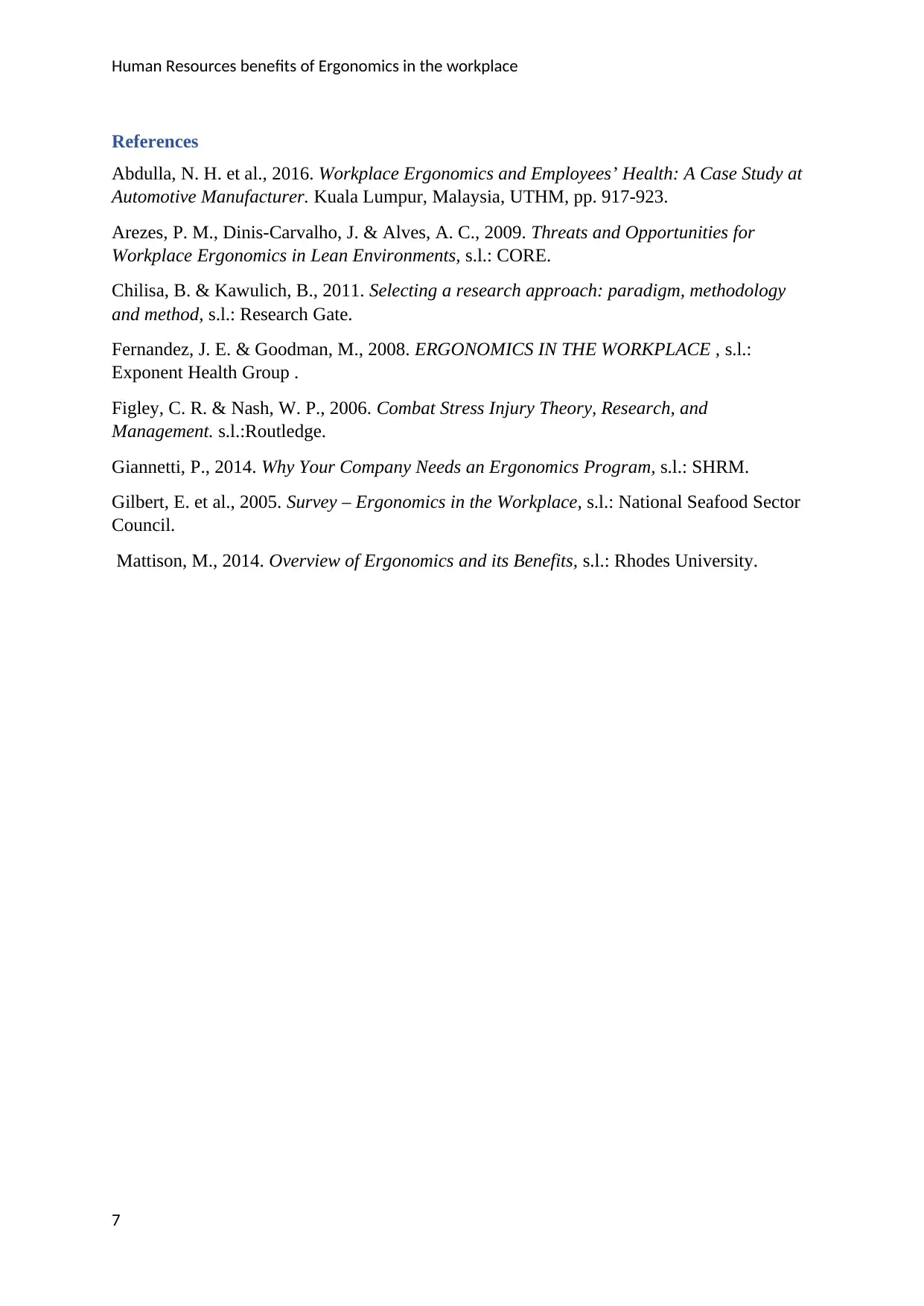
Human Resources benefits of Ergonomics in the workplace
References
Abdulla, N. H. et al., 2016. Workplace Ergonomics and Employees’ Health: A Case Study at
Automotive Manufacturer. Kuala Lumpur, Malaysia, UTHM, pp. 917-923.
Arezes, P. M., Dinis-Carvalho, J. & Alves, A. C., 2009. Threats and Opportunities for
Workplace Ergonomics in Lean Environments, s.l.: CORE.
Chilisa, B. & Kawulich, B., 2011. Selecting a research approach: paradigm, methodology
and method, s.l.: Research Gate.
Fernandez, J. E. & Goodman, M., 2008. ERGONOMICS IN THE WORKPLACE , s.l.:
Exponent Health Group .
Figley, C. R. & Nash, W. P., 2006. Combat Stress Injury Theory, Research, and
Management. s.l.:Routledge.
Giannetti, P., 2014. Why Your Company Needs an Ergonomics Program, s.l.: SHRM.
Gilbert, E. et al., 2005. Survey – Ergonomics in the Workplace, s.l.: National Seafood Sector
Council.
Mattison, M., 2014. Overview of Ergonomics and its Benefits, s.l.: Rhodes University.
7
References
Abdulla, N. H. et al., 2016. Workplace Ergonomics and Employees’ Health: A Case Study at
Automotive Manufacturer. Kuala Lumpur, Malaysia, UTHM, pp. 917-923.
Arezes, P. M., Dinis-Carvalho, J. & Alves, A. C., 2009. Threats and Opportunities for
Workplace Ergonomics in Lean Environments, s.l.: CORE.
Chilisa, B. & Kawulich, B., 2011. Selecting a research approach: paradigm, methodology
and method, s.l.: Research Gate.
Fernandez, J. E. & Goodman, M., 2008. ERGONOMICS IN THE WORKPLACE , s.l.:
Exponent Health Group .
Figley, C. R. & Nash, W. P., 2006. Combat Stress Injury Theory, Research, and
Management. s.l.:Routledge.
Giannetti, P., 2014. Why Your Company Needs an Ergonomics Program, s.l.: SHRM.
Gilbert, E. et al., 2005. Survey – Ergonomics in the Workplace, s.l.: National Seafood Sector
Council.
Mattison, M., 2014. Overview of Ergonomics and its Benefits, s.l.: Rhodes University.
7
1 out of 7
Related Documents
Your All-in-One AI-Powered Toolkit for Academic Success.
+13062052269
info@desklib.com
Available 24*7 on WhatsApp / Email
![[object Object]](/_next/static/media/star-bottom.7253800d.svg)
Unlock your academic potential
Copyright © 2020–2025 A2Z Services. All Rights Reserved. Developed and managed by ZUCOL.





